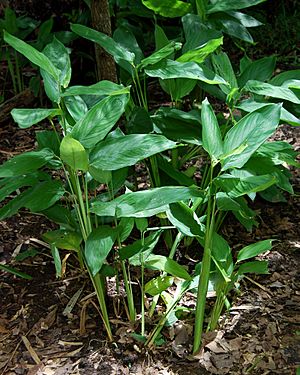West Indian arrowroot facts for kids
Quick facts for kids Arrowroot |
|
|---|---|
 |
|
| Scientific classification | |
| Genus: |
Maranta
|
| Species: |
arundinacea
|
| Synonyms | |
|
|
| Nutritional value per 100 g (3.5 oz) | |
|---|---|
| Energy | 271 kJ (65 kcal) |
|
13.39 g
|
|
| Dietary fiber | 1.3 g |
|
0.2 g
|
|
|
Protein
|
4.24 g
|
| Vitamins | Quantity
%DV†
|
| Thiamine (B1) |
12%
0.143 mg |
| Riboflavin (B2) |
5%
0.059 mg |
| Niacin (B3) |
11%
1.693 mg |
| Pantothenic acid (B5) |
6%
0.292 mg |
| Vitamin B6 |
20%
0.266 mg |
| Folate (B9) |
85%
338 μg |
| Minerals | Quantity
%DV†
|
| Iron |
17%
2.22 mg |
| Magnesium |
7%
25 mg |
| Manganese |
8%
0.174 mg |
| Phosphorus |
14%
98 mg |
| Potassium |
15%
454 mg |
| Zinc |
7%
0.63 mg |
|
Link to USDA Database entry
|
|
| †Percentages estimated using US recommendations for adults. | |
Arrowroot (scientific name: Maranta arundinacea) is a large plant that lives for many years. It grows naturally in rainforests. People also call it maranta or West Indian arrowroot.
Arrowroot flour is made from this plant. Most of it comes from St. Vincent and the Grenadines today. This plant was one of the first foods grown by people in northern South America. Evidence shows it was used as far back as 8200 BC. Sometimes, arrowroot is mistakenly sold as Curcuma angustifolia.
Contents
What is Arrowroot?
Arrowroot is a plant that can grow from about 1 foot (0.3 meters) to 5 feet (1.5 meters) tall. Its leaves are long and pointed, shaped like a spear. The part of the plant we eat is called a rhizome. This is an underground stem that looks like a root.
Small white flowers grow in pairs about 90 days after the plant is put in the ground. Arrowroot plants rarely make seeds. Instead, new plants usually grow from a piece of the rhizome that has a bud. The rhizomes are ready to be picked 10 to 12 months after planting. You know they are ready when the plant's leaves start to wilt and die. These edible rhizomes are thick and cylindrical. They can be 8 to 18 inches (20 to 45 cm) long.
Where Arrowroot Grows
The arrowroot plant likely first grew in the Amazon rainforest. This area is in northwestern Brazil and nearby countries. It grows best in warm temperatures, between 73°F (23°C) and 84°F (29°C). It also needs a lot of rain, about 59 to 79 inches (150 to 200 cm) each year. The rhizomes can survive cooler temperatures, as low as 41°F (5°C), when they are not actively growing.
In the United States, arrowroot is grown outdoors mainly in southern Florida.
Where is Arrowroot Found Today?
Maranta arundinacea is native to many places. These include Mexico, Central America, and the West Indies. It also grows in South America.
People now grow arrowroot in many warm countries around the world. It has become a natural part of the plant life in places like Jamaica, Bahamas, Bermuda, India, Sri Lanka, China, and the Philippines.
The Caribbean country of St. Vincent and the Grenadines is the biggest producer of arrowroot flour in the world. In Kerala, India, arrowroot is grown to make an easy-to-digest starch. It is called bilathi koova there.
Arrowroot in Ancient Times
Scientists use radio-carbon dating to find out how old things are. This method shows that M. arundinacea was one of the first plants grown by people in ancient South America. Arrowroot, along with other plants like squash, was grown in northern South America and Panama between 8200 BC and 5600 BC.
Some experts think that early Native Americans first used arrowroot for medicine. They might have used it as a paste to pull poison from wounds caused by spears or arrows.
Early Evidence of Use
Evidence of arrowroot being used as food was found from 8200 BC. This was at a place called San Isidro in Colombia. Starch grains from arrowroot were found on tools used for grinding. It's not clear if the arrowroot was gathered from the wild or grown on purpose. However, the San Isidro site is high up, about 5,577 feet (1,700 meters). This is probably too high for arrowroot to grow naturally. So, people might have brought the plant from lower rainforest areas to grow it there. Stone tools used for farming have been found from as far back as 7700 BCE. These were found about 93 miles (150 km) north of San Isidro.
Growing arrowroot in these early times was probably on a small scale. People might have planted just a few plants in gardens near streams. This would ensure the plants got enough water during their growing season. Getting the starch from the tough roots was likely difficult. The roots had to be pounded or ground first. Then, they were soaked in water to separate the starch from the fibers. This starch is very easy to digest.
How Arrowroot is Used
Today, arrowroot starch is used in many ways. It is found in food products and sweets. It is also used in things like cosmetics and glue. The leftover part after the starch is taken out has a lot of fiber. This can be used to feed farm animals.
Gallery
See also
 In Spanish: Maranta arundinacea para niños
In Spanish: Maranta arundinacea para niños



